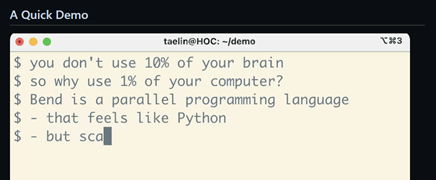Very interesting, and very early stage rn.
Yet, it runs on massively parallel hardware like GPUs, with near-linear speedup
What a bold claim…
@eveninghere @ruffsl that claim’s correct. But so far it doesn’t have great performance on a single core.
Sorry, how could it be correct? On that page there’s no explanation on what they’re measuring to begin with. No mention on the benchmark set up either. There are problems that can never scale linearly due to the reality of hardware.
the “will linearly speedup anything [to the amount of parallel computation available]” claim is so stupid that I think it’s more likely they meant “only has a linear slowdown compared to a basic manual parallel implementation of the same algorithm”
Good thing they don’t claim that. Read the README, they make very nuanced and reasonable claims about their very impressive language
Yeah, and still… the example code in github is also bad. The arithmetic is so tiny that the performance of the execution can be worse than the serial execution. It makes the impression that the language parallelizes everything possible, in which case the execution would possibly get stuck at some parallel parts that’s not worth parallelizing.
There’s a huge chunk of technical information missing for an expert to imagine what’s going on. And too many comments here still praise the language. They don’t mention anything concrete in those texts. This makes me REALLY skeptical of this post.
Edit: there are many posts that make up BS for job interviews. I sure hope this is not one of those.
The github blurb says the language is comparable to general purpose languages like python and haskell.
Perhaps unintentionally, this seems to imply that the language can speed up literally any algorithm linearly with core count, which is impossible.
If it can automatically accelerate a program that has parallel data dependencies, that would also be a huge claim, but one that is at least theoretically possible.
If it can automatically accelerate a program that has parallel data dependencies, that would also be a huge claim, but one that is at least theoretically possible.
You nailed it! That’s exactly what this is! Read through their README, and the paper attached. It’s very cool tech
Is this a PR? The link is PR with no substance, praises itself without any details on benchmarking setup, and still I see some comments here being positive.
I hope the demo starts soon…

(What a bullshit correlation/equation to start with.)
This could be game changing for introducing shader programming to more developers if it pans out.
Yikes, those high CPU threads. Definitely needs some more polishing.
what’s wrong with them? are you sure it’s just not set to use 100% of all cores, and then the OS does some shuffling?
Futhark is another language with the same goals, executed differently.
Gotta read the paper, this is a game-changer.
Funny how they benchmarked an ARM CPU and not a x64 one as if ARM CPUs are now faster than x64 ones.
Here is an alternative Piped link(s):
https://piped.video/watch?v=HCOQmKTFzYY
Piped is a privacy-respecting open-source alternative frontend to YouTube.
I’m open-source; check me out at GitHub.









